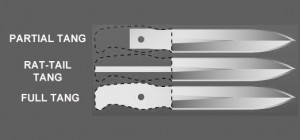Last time I wrote, I talked about knife tangs and why they matter in terms of knife usage. Now I will discuss more types of knife tangs that you should own.
Tapered Tang
A tapered tang has a narrow shape which allows for a lighter weight and feel to the knife when handled by a user, but it remains tough and hard to fracture.
Push Tang
A push tang may seem like a hastily put-together knife, but it has some value, in terms of being potentially less expensive than other knives with different tangs. This is because it is typically shorter in length than other tangs, and therefore, it contains less metal. It apparently costs less to make during the manufacturing process for this reason.
Extended Tang
An extended tang goes beyond the end of the knife handle and, of any tang, it gives the knife one of the most durable overall structures because it has one of the highest metal contents of all knife tangs. The end of the tang, which is exposed, can be used like a hammer, for added practicality and versatility.
Hidden Tang
The hidden tang is, like its name, easily concealed within the knife handle, but it is thicker than the stick tang, so it is more robust and sturdier in comparison.
Encapsulated Tang
This tang is encased within the handle, because, during the manufacturing, the handle is cast over the tang. The encapsulated tang runs the full length of the knife handle, and this feature gives it a solid, resilient quality not present in other knife tangs.
Stick Tang
With this tang, honestly, you are better off with a different tang, because this one is the least durable and is the most likely to break off, as it is the thinnest of the tangs and has the least metal in its composition.
Be the first to see flash sales, giveaways, product announcements, and more!


